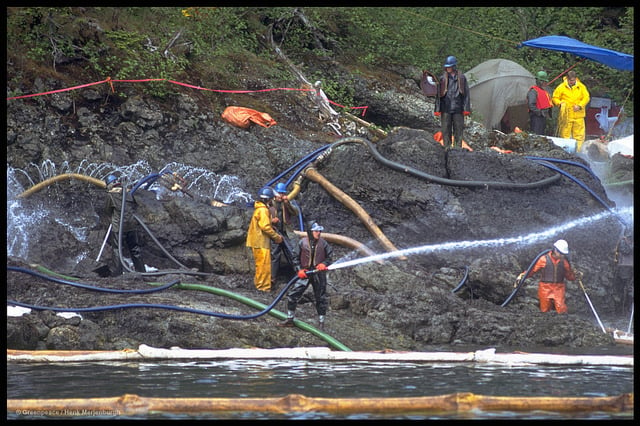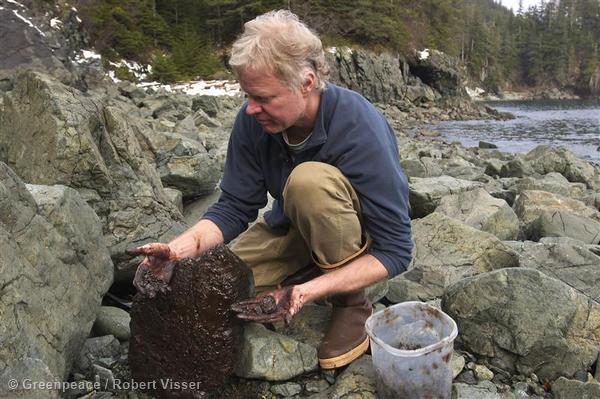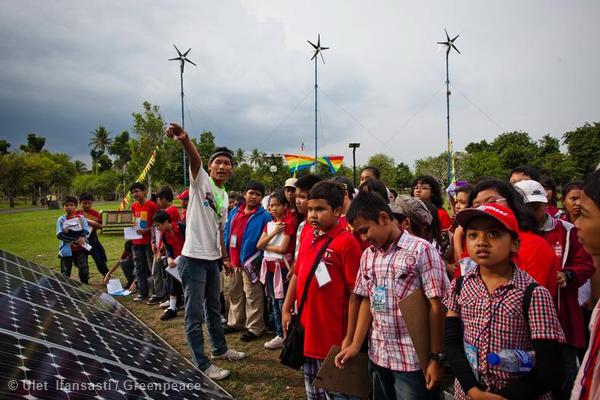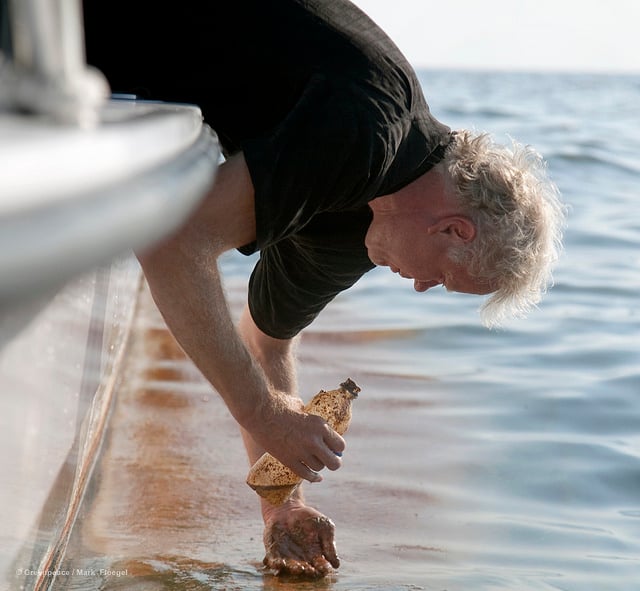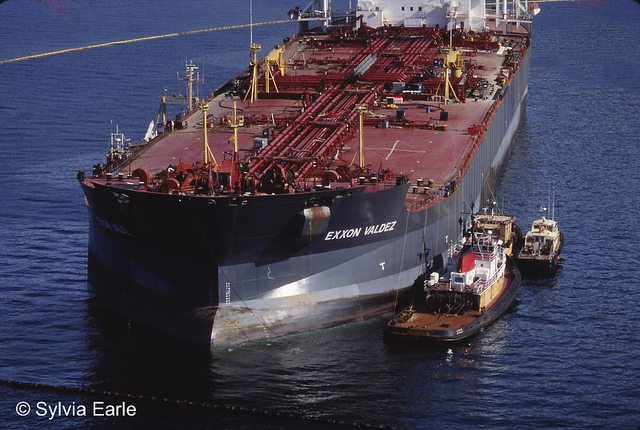
Monday is the 25-year anniversary of the 1989 Exxon Valdez oil spill in Alaska. Now seems a good time to reflect on lessons learned, and lessons lost.
1. Oil spill “cleanup” is a myth. Once oil has spilled, it is impossible to effectively contain it, recover it, and clean it up.
Exxon spent more than $2 billion trying to clean up its Alaska spill, but recovered less than 7 percent. BP spent $14 billion trying to clean up its 2010 Deepwater Horizon spill, and although they collected some at the wellhead, burned and dispersed some (with toxic chemicals), it recovered only 3 percent from the sea surface and beaches.
Seldom is more than 10 percent of a marine oil spill recovered. We should insist that industry and government are prepared to respond to a spill, but we should not expect any spill response to be effective.
This is particularly true for spills in ice-covered Arctic waters.
2. Oil spills can cause long-term environmental damage. Industry rhetoric aside, oil spills cause long-term, even permanent, ecological injury. Oil, water, fish, and wildlife don’t mix.
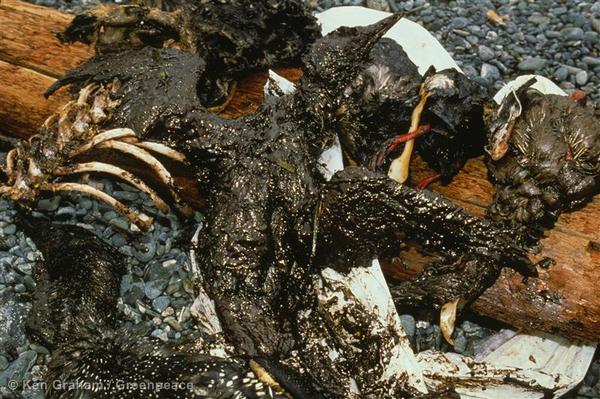
Dead otter, loon, and other crude-oil covered animals decompose on the shore after the Exxon Valdez oil spill disaster.
Millions of innocent organisms marine mammals, birds, fish, and invertebrates were killed by the Exxon Valdez spill. A quarter of a century later, only 13 of the 32 monitored populations, habitats, and resource services injured in the spill are considered fully “recovered” or “very likely recovered.”
Some populations, such as Pacific herring, pigeon guillemots, and the AT1 killer whale pod, are still listed as “not recovering.” Meanwhile, thousands of gallons of Exxon Valdez oil still remains in beach sediments in Prince William Sound.
3. Oil spill restoration is impossible. Once a coastal or marine ecosystem is “broken,” it cannot be “fixed.” All the spill restoration money in the world can’t repair an injured coastal ecosystem. The best (and least) we can do is to protect a spill-injured ecosystem from additional human-caused injury, giving it the best chance to recover naturally.
4. Officials habitually understate spill risk, size, and impact. Government and industry officials always downplay the risk, size, and impact of spills. We should not trust official assertions of the “low risk” of offshore drilling, tankers, or pipelines, nor should we trust industry assertions regarding size and impact of a spill.
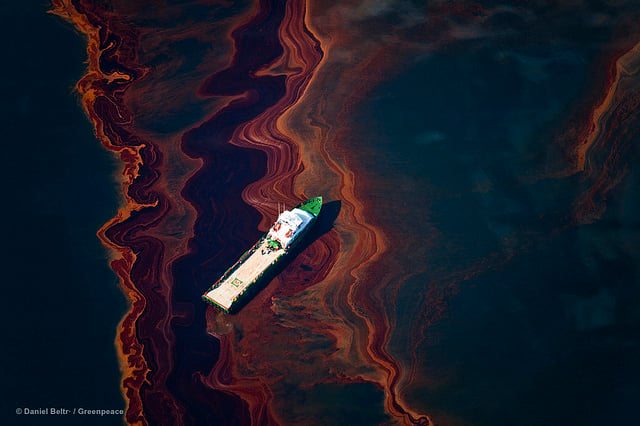
A view from an altitude of 3200 ft of oil on the sea surface after the Deepwater Horizon wellhead disaster. The BP -leased oil platform exploded and sank after burning, leaking more than 200,000 gallons of crude oil per day into the sea.
5. Prevention is key. We can and must reduce spill risk as much as possible, regardless of cost. The tanker spill prevention system put into Prince William Sound after the Exxon Valdez spill was arguably one of the best anywhere twin tug escorts for every laden tanker, continuous vessel tracking, double hulls on all tankers (and some with twin engines, twin rudders, and bow thrusters), two licensed mariners on the bridge, expanded pilotage, ice-detecting radar, alcohol screening of crew, weather restrictions, better tanker inspection, and so on.
Unfortunately, few of these prevention measures have been implemented in other at-risk waterways, such as the Arctic, the Aleutians, Puget Sound, the Gulf of Mexico, or the Atlantic coast.
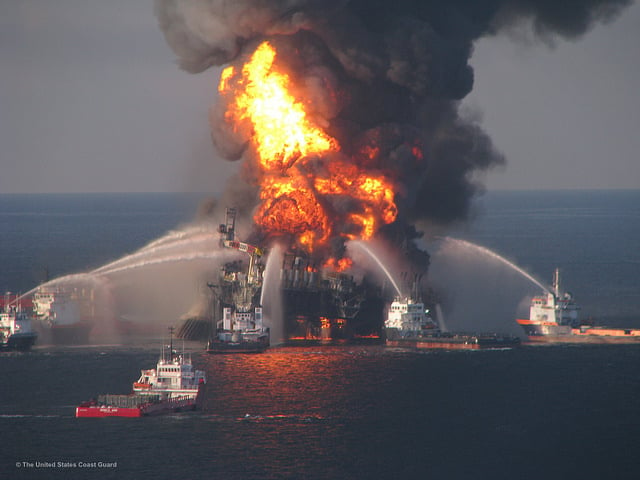
Fire boat response crews battle the blazing remnants of the off shore oil rig Deepwater Horizon. Multiple United States Coast Guard helicopters, planes and cutters responded to rescue the BP Deepwater Horizon’s 126 person crew. Eleven workers died and millions of barrels of crude oil gushed into the Gulf in worst oil spill in United States history.
6. Oversight by the public is critical. Even with the best spill prevention system possible, there will always be human error and mechanical failure. Industry and government must remain vigilant, 24/7/365. To guard against complacency, allstakeholders need to be empowered to provide effective, independent oversight.
7. Liability motivates safety. To motivate safe, responsible conduct of oil development, sufficient financial liability for spills is essential. Congress has not increased oil spill liability in the past 24 years, and limits remain shamefully low nationwide. If we eliminate oil spill liability limits altogether, the industry will find it more cost-effective to enact best available safety measures.
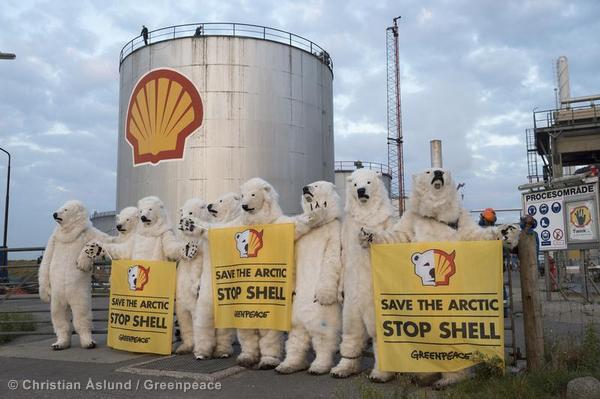
Greenpeace activists dressed as polar bears, protest at the Shell oil refinery in Fredericia, Denmark, to expose the company’s plans to drill for oil in the fragile Arctic region.
8. Oil money corrupts democracy. Big oil is big business, and its concentrated wealth distorts democratic governance the world over. Oil money flows freely into political campaigns, lobbying, bribes, advertising, and results in self-serving, perverse public policy, such as the billions of dollars in subsidies the global fossil fuel industry receives each year.
As oil money flows, democratic governance is subverted, andoil becomes more curse than blessing. In Alaska, as in most oil states and countries,big oil’s corrupting influence on government, even the state university, is legendary.
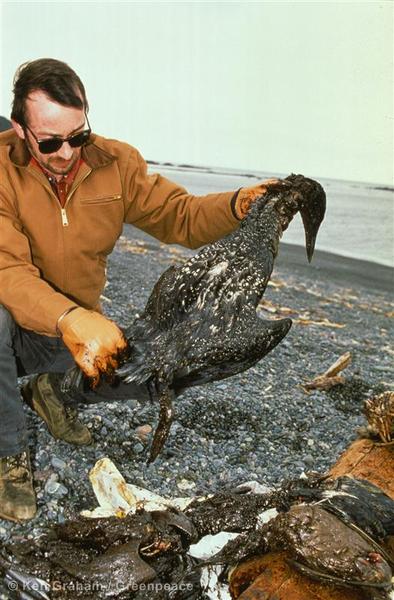 9. It’s time to end our oil addiction.Oil spills are only the most visible, acute impact of our oil addiction. Other impacts include chronic habitat loss, human health damage, distortion of economies and social systems, oil wars, and climate change now affecting every corner of the world.
9. It’s time to end our oil addiction.Oil spills are only the most visible, acute impact of our oil addiction. Other impacts include chronic habitat loss, human health damage, distortion of economies and social systems, oil wars, and climate change now affecting every corner of the world.
At the time of Exxon Valdez spill, the world used 63 million barrels per day (bpd), the U.S. used 17 million bpd, and atmospheric CO2 levels were at 350 ppm. More than twice as much oil has been used since Exxon Valdez over than 700 billion barrels than in all of human history prior to that date.
Twenty-five years later, world oil use is now 91 million bpd. U.S. oil use is 20 million bpd, half of it still wasted. Several wars have been fought over oil. Atmospheric CO2 levels are 400 ppm and rising. Arctic sea ice has declined by about half. Glaciers are disappearing. Storms, droughts, floods, and heat extremes have increased. And climate change has cost millions of human lives and trillions of dollars.
10. The need for a sustainable society.The transcendent lesson of oil spills, and other industrial disasters, is that our society is living beyond the carrying capacity of the Earth, destroying the biosphere, and is dangerously unsustainable.
Just since the 1989 Alaska spill, world population has increased from 5 billion to more than 7 billion; the world economy (gross world product) has more than doubled, depleting material, energy, and ecological resources; the world haslost over 130 million hectares of forest; and over one million species, most unnamed and unnoticed,have gone extinct. The real lesson from disasters likeExxon ValdezandDeepwater Horizonis that we need to attend to the more gradual, less obvious, but more dangerous degradation of the biosphere, and get serious about sustainability.
Heres the bottom line: Spills will occur, they can’t be cleaned up, they can cause long-term damage, and restoration is impossible. Where we produce and transport oil, it must be done with the highest possible safety standards. We need to use oil much more efficiently, and stop wasting it. Above all, we urgently need to kick our carbon habit, and transition to a sustainable society.
A version of this post previously appeared on HuffingtonPost.

